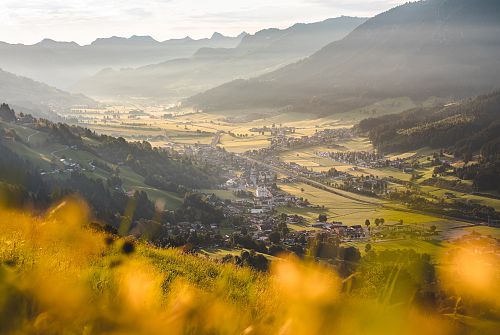Chronicle Brixen im Thale
The history in brief
Brixen is the geographic, historic and cultural centre of Brixental Valley, to which it gave its name. The name Brixen indicates a Celtic settlement, maybe the name is based on the Celtic root "Rika", the root word "Brixana" of which signifies a "place by the small rift". According to another version, it could come from the pre-Roman word "Brik" (mountain), which eventually morphed into "Brixina" (meaning "place on the mountain"). The crest conferred in 1972 shows a flanged axe from the Bronze Age and was found on Salvenberg.
- 788 is the first time the records of Salzburg Bishop Arno mention a church in Brixen ("ad Prixina").
- 1481 reference to the school - schoolmaster was likely Pastor Wilhelm Taz, founder of the Taz-library as a significant cultural monument to the late Middle Ages.
- In the 16th century, there was mining at Götschen and Traholz (Zinnsberg).
- 1589 saw the construction of the highest located pilgrimage church in Austria, which was dedicated to St. Johannes on Hohe Salve.
- 1648 End of the Thirty Years' War - The tradition of the Antlassritt horse procession for Corpus Christi was born. It is held out of gratitude for averting the danger of the Swedish invasion. Only men from Brixen, Westendorf and Kirchberg are allowed to participate. This procession on horseback is a genuine custom and cultural attraction of trans-regional significance.
- 1790 sees the start of construction of the district church according to blueprints by Wolfgang Hagenauer and Andreas Hueber.
- 1797 the late baroque-classicistic church is dedicated in honour of the Assumption of Mary and of St. Martin., and 1812 home to its own deanery.
- 1822 sees the construction of the "Maria-Louisenbad", which was in operation until the 1960s. Archduchess Maria Louise bestows the name on the healing bath when visiting Brixen.
- 1875 Inauguration of the railway line Wörgl – Salzburg through Brixental Valley, named after the daughter of Emperor Franz Josef "Giselabahn". Thanks to the construction of the railway line, tourism gets a significant boost.
- 1963 Construction of the T-bar lifts Badhaus and Kandleralm
- 1969 Inauguration of the outdoor pool (the swimming lake was built only in 1990)
- 1970 opening of the lifts in Hochbrixen, 1977 then sees the merger of the ski areas into the "Skiwelt Wilder Kaiser – Brixental".
- 2008 Opening of the bypass and inauguration of the Skiweltbahn up to Choralm



